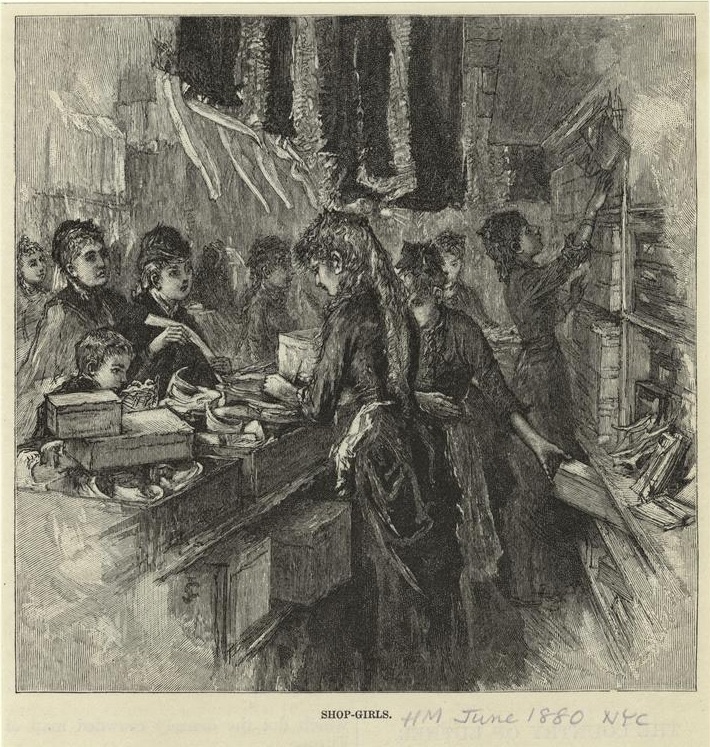Shop Girls
The Miriam and Ira D. Wallach Division of Art, Prints and Photographs: Picture Collection, The New York Public Library. “Shop-Girls.” The New York Public Library Digital Collections. 1880. https://digitalcollections.nypl.org/items/510d47e1-05d5-a3d9-e040-e00a18064a99.
Background
After the Civil War, industrialization of the garment industry and cheap labor made clothing more affordable and accessible. Middle-class women bought new outfits more frequently. The invention of the department store further changed the shopping experience in urban communities. Shopping soon became a popular pastime. Department stores offered a larger variety of items and regular sales. Shoppers dined at restaurants inside the stores, allowing for a full-day experience.
Before the introduction of department stores, people bought clothes in small stores where sales clerks were willing to negotiate prices. Salespeople were typically men, as negotiating was considered a special skill. However, department stores offered products at set prices. Salespeople need not be skilled negotiators as negotiating was no longer a common practice.
Department stores hired more women and paid them less than their male counterparts. In 1880, fewer than 8,000 women worked as sales clerks. By 1890, that number had grown to over 58,000. By the early 20th century, female sales clerks outnumbered male clerks. Department stores wanted staff that attracted the most desirable customers. As a result, many stores hired primarily white, native-born women. Working as a “shop girl” was considered one of the best jobs. It was a respectable position in a clean, safe working environment.
About the Image
The realities of work in department stores were far from ideal though. Shop girls often made less money than the factory workers who produced the clothing they sold. And they worked longer hours. Workers were expected to stay after the store closed to check inventory, without additional pay. Sexual harassment from managers and customers was commonplace.
Middle- and upper-class women interested in bettering the conditions for the working-class worried about the radicalism of labor activists after the Haymarket Affair. They saw shop girls, who were primarily white and native-born women, as more sympathetic than other working-class women. Wealthy women used their power as consumers to improve working conditions for these shop girls by only purchasing from fair employers.
Vocabulary
- inventory: A complete list and count of all items in a store.
Discussion Questions
- What does this image tell you about working and shopping in a department store?
- What do you imagine a typical workday felt like for a shop girl in a department store?
- What were the advantages of working in a department store? What challenges did the shop girls face?
- Wages had little effect on a job’s desirability. What does that say about how issues of race, class, and social position influenced the experience of American working women?
Suggested Activities
- APUSH Connection: 6.10: Development of the Middle Class
- Explore the different hierarchies within working-class women’s jobs. Compare the experiences of shop girls with those of Black domestic workers, Irish domestic workers, factory workers in New Jersey, and factory workers in Atlanta. What were the advantages and disadvantages of these jobs? What sort of women dominated these positions and why?
- Shop girls interacted with middle- and upper-class white women on a daily basis. Consider the two sides of the shopping experience by pairing this resource with photographs of upper-class women and paintings of women by Mary Cassatt.
- Discuss the moral role of women during this time period by pairing this resource with the temperance movement, the Page Act, and the Comstock Act. Why would white women prefer to work in department stores? How did the ideal of the American woman affect that choice?
Themes
WORK, LABOR, AND ECONOMY







